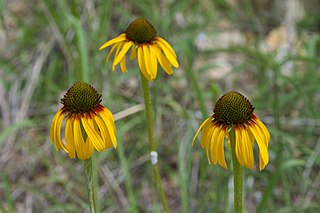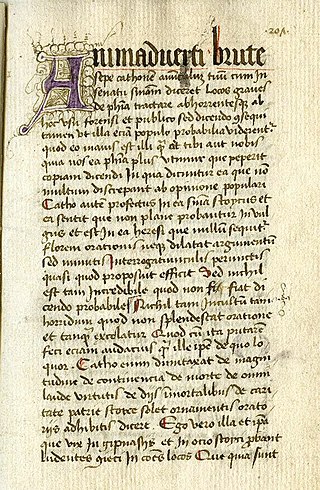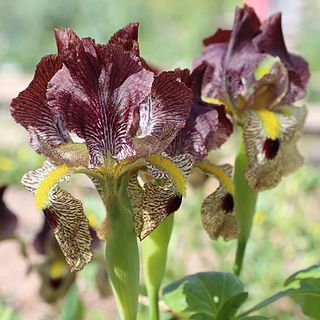
Vitellaria paradoxa, commonly known as shea tree, shi tree, or vitellaria, is a tree of the family Sapotaceae. It is the only species in the genus Vitellaria, and is indigenous to Africa.

The South American lungfish, also known as the American mud-fish and scaly salamanderfish, is the single species of lungfish found in swamps and slow-moving waters of the Amazon, Paraguay, and lower Paraná River basins in South America. Notable as an obligate air-breather, it is the sole member of its family Lepidosirenidae, although some authors also place Protopterus in the family. In Brazil, it is known by the indigenous language Tupi name piramboia, which means "snake-fish", and synonyms pirarucu-bóia, traíra-bóia, and caramuru.

Hymenopodidae is a family of the order Mantodea (mantises), which contains six subfamilies. Some of the species in this family mimic flowers and are found camouflaged among them; these are called flower mantises. Their coloration is aggressive mimicry, luring prey to approach close enough to be seized and eaten.

Acacia paradoxa is a plant in the family Fabaceae. Its common names include kangaroo acacia, kangaroo thorn, prickly wattle, hedge wattle and paradox acacia.
Ceratocystis paradoxa or Black Rot of Pineapple is a plant pathogen that is a fungus, part of the phylum Ascomycota. It is characterized as the teleomorph or sexual reproduction stage of infection. This stage contains ascocarps, or sacs/fruiting bodies, which contain the sexually produced inoculating ascospores. These are the structures which are used primarily to survive long periods of time or overwinter to prepare for the next growing season of its host. Unfortunately, the sexual stage is not often seen in the natural field but instead the anamorph, or asexual stage is more commonly seen. This asexual stage name is Thielaviopsis paradoxa and is the common cause of Black rot or stem-end rot of its hosts.

Echinacea paradoxa, the yellow coneflower, Bush's purple coneflower, or Ozark coneflower, is a North American species of flowering plant in the family Asteraceae. It is native to southern Missouri, Arkansas, and south-central Oklahoma. It is listed as threatened in Arkansas.

Fallugia is a monotypic genus of flowering plants containing the single species Fallugia paradoxa, which is known by the common names Apache plume and póñil. This plant is native to the southwestern United States and northern Mexico, where it is found in arid habitats such as desert woodlands and scrub.

Myodocarpaceae is a family of flowering plants which contains 2 genera and 15 species. The family is accepted under the APG IV system and placed in the order Apiales. In earlier systems the two genera were included among the Araliaceae.

n.paradoxa: international feminist art journal was a biannual academic journal covering feminist art criticism and the work of women artists since the 1970s. It was published by KT press and the editor-in-chief was Katy Deepwell (London).
Serixia is a genus of longhorn beetles of the subfamily Lamiinae, containing the following species:

The Paradoxa Stoicorum is a work by the academic skeptic philosopher Cicero in which he attempts to explain six famous Stoic sayings that appear to go against common understanding: (1) virtue is the sole good; (2) virtue is the sole requisite for happiness; (3) all good deeds are equally virtuous and all bad deeds equally vicious; (4) all fools are mad; (5) only the wise are free, whereas all fools are enslaved; and (6) only the wise are rich.

Iris paradoxa is a species of flowering plant native to western Asia. It has large upright petals and smaller lower petals, which is unique amongst most iris forms. They come in various shades from white, lavender, mauve, medium purple, violet, dark purple to black. It has a black or purplish black beard on the lower petals. It comes from the region of Transcaucasia, and is found in the countries of Iran, Turkey, Armenia and in Azerbaijan.
Serixia buruensis is a species of beetle in the family Cerambycidae. It was described by Stephan von Breuning in 1958.
Serixia cinereotomentosa is a species of beetle in the family Cerambycidae. It was described by Stephan von Breuning in 1958.
Serixia novaebritanniae is a species of beetle in the family Cerambycidae. It was described by Stephan von Breuning in 1958.
Serixia longicornis is a species of beetle in the family Cerambycidae. It was described by Francis Polkinghorne Pascoe in 1858.
Serixia prolata is a species of beetle in the family Cerambycidae. It was described by Francis Polkinghorne Pascoe in 1858.
Serixia sedata is a species of beetle in the family Cerambycidae. It was described by Francis Polkinghorne Pascoe in 1862.
Serixia phaeoptera is a species of beetle in the family Cerambycidae. It was described by Per Olof Christopher Aurivillius in 1927.

Bartheletia paradoxa is a species of dimorphic fungus and is the only member of the genus Bartheletia. Bartheletia is the only genus in the family Bartheletiaceae, which is the only family in Bartheletiales, which in turn is the only order in the class Bartheletiomycetes.










